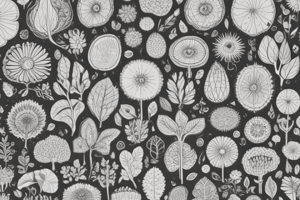Podcast
Questions and Answers
Which cellular unit in plants is responsible for conducting water and nutrients?
Which cellular unit in plants is responsible for conducting water and nutrients?
- Palisade parenchyma cells
- Collenchymatic tissues
- Spongy mesophyll cells
- Root hair cells (correct)
What is the primary function of palisade and spongy layers in plants?
What is the primary function of palisade and spongy layers in plants?
- Gas exchange
- Photosynthesis (correct)
- Structural support
- Water uptake
Which part of a plant captures sunlight for photosynthesis?
Which part of a plant captures sunlight for photosynthesis?
- Spongy mesophyll (correct)
- Cuticle
- Xylem
- Roots
What is the function of the cuticle and waxy epidermis in plants?
What is the function of the cuticle and waxy epidermis in plants?
Which plant organ is responsible for anchoring the plant and absorbing moisture and nutrients from the soil?
Which plant organ is responsible for anchoring the plant and absorbing moisture and nutrients from the soil?
What specialized tissue in plants facilitates the transport of water and dissolved minerals throughout the entire plant?
What specialized tissue in plants facilitates the transport of water and dissolved minerals throughout the entire plant?
What is the main function of xylem in a plant?
What is the main function of xylem in a plant?
Which part of a flower attracts pollinators?
Which part of a flower attracts pollinators?
What is the role of anthers in a flower?
What is the role of anthers in a flower?
Which process allows succulent plants to minimize water loss while still producing carbohydrates?
Which process allows succulent plants to minimize water loss while still producing carbohydrates?
What occurs during cross-pollination in plants?
What occurs during cross-pollination in plants?
How does aerenchyma benefit plants growing in dense root systems?
How does aerenchyma benefit plants growing in dense root systems?
Flashcards
Plant Tissue
Plant Tissue
Specialized cells grouped together to perform a specific function in a plant.
Plant Cells
Plant Cells
The basic building blocks of plants, responsible for carrying out various functions.
Xylem
Xylem
Tissue responsible for transporting water and dissolved minerals throughout the plant.
Phloem
Phloem
Signup and view all the flashcards
Palisade Parenchyma
Palisade Parenchyma
Signup and view all the flashcards
Spongy Mesophyll
Spongy Mesophyll
Signup and view all the flashcards
Cuticle and Epidermis
Cuticle and Epidermis
Signup and view all the flashcards
Roots
Roots
Signup and view all the flashcards
Stems
Stems
Signup and view all the flashcards
Leaves
Leaves
Signup and view all the flashcards
Pollination
Pollination
Signup and view all the flashcards
Plant Adaptation
Plant Adaptation
Signup and view all the flashcards
Study Notes
Unraveling Plant Anatomy
Understanding the complex structure and function of plants involves exploring various levels of organization—from cells to whole organisms. Let's delve into the fascinating realm of plant anatomy, illuminating key components that contribute to a plant's life cycle and resilience.
Cells and Tissues
Plants consist primarily of specialized cells organized into tissues within organs, such as roots, stems, and leaves. These cellular units serve specific functions, like conducting water and nutrients (vascular tissue), providing structural support (collenchymatic and sclerenchymatic tissues), and photosynthesizing food (palisade and spongy layers).
Organ Systems
Roots anchor plants and absorb moisture and nutrients from the soil. Root hair cells increase surface area for better uptake of essential elements, whereas xylem and phloem vascular bundles transport water and dissolved minerals throughout the entire plant. Stems provide structural support while facilitating upward growth, and leaves capture sunlight for photosynthesis.
Leaf Structure
Leaves contain palisade parenchyma cells which perform primary photosynthesis near the upper epidermis. Below these lie the spongy mesophyll, containing air spaces that enhance gas exchange and aid in transpiration. The lower, protective outermost layer consists of the cuticle and waxy epidermis.
Xylem and Phloem
Composed mainly of dead cells, xylem conducts water and mineral nutrients to the rest of the plant. Meanwhile, living phloem cells carry sugars produced via photosynthesis throughout the plant.
Flower Structure
Flowers possess many unique parts, including sepals, petals, stamens, and carpels. Sepals protect the developing flower bud while petals attract pollinators. Stamen filaments bear anthers containing microspore mother cells, which develop into male gametes (pollen grains), while carpel ovaries house megaspore mother cells that evolve into female gametes (embryo sac cells). Together, these floral components ensure successful pollination and seed formation.
Pollination Process
Cross-pollination occurs when foreign pollen reaches a flower's stigma, allowing the development of seeds and fruit. Wind and insects account for the majority of natural pollinator agents involved in the transfer process.
Adaption to Environmental Conditions
Plants exhibit remarkable adaptation strategies to cope with varying environmental challenges. For instance, certain species produce aerenchyma, intercellular spaces filled with air, which improve water and oxygen diffusion within dense root systems that grow in both wet and dry soils. Similarly, crassulacean acid metabolism (CAM) allows succulent plants to minimize water loss while still producing carbohydrates through photosynthesis.
Exploring the diverse facets of plant anatomy helps us understand the complexity of our natural environment and provides valuable insight into the importance of plant conservation efforts worldwide.
Studying That Suits You
Use AI to generate personalized quizzes and flashcards to suit your learning preferences.




